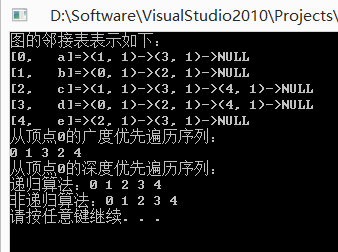深度优先搜索
post by:追风剑情 2014-8-30 21:28
程序语言 C++
开发工具 Visual Studio2010
Graph.h文件
#define MAXVEX 5 //图中最大顶点数
/////////////////////////////////////////////////////////////////////
//
// 定义邻接表数据结构
//
/////////////////////////////////////////////////////////////////////
//定义顶点类型为10个字符的字符数组
typedef char VertexType[10];
typedef struct edgenode
{
int adjvex; //邻接点序号
int value; //边的权值
struct edgenode *next; //下一条边的顶点
} ArcNode; //每个顶点建立的单链表中结点的类型
typedef struct vexnode
{
VertexType data; //顶点信息
ArcNode *firstarc; //指向第一条边结点
} VHeadNode; //单链表的头结点类型
typedef struct
{
int n,e; //n为实际顶点数,e为实际边数
VHeadNode adjlist[MAXVEX]; //单链表头结点数组
} AdjList; //图的邻接表类型
/////////////////////////////////////////////////////////////////////
//
// 定义邻接矩阵数据结构
//
/////////////////////////////////////////////////////////////////////
typedef struct vertex
{
int adjvex; /*顶点编号*/
VertexType data;/*顶点信息*/
} VType; /*顶点类型*/
typedef struct graph
{
int n,e; /*n为实际顶点数,e为实际边数*/
VType vexs[MAXVEX]; /*顶点集合*/
int edges[MAXVEX][MAXVEX]; /*边的集合*/
} AdjMatix; /*图的邻接矩阵类型*/
GSearch.cpp文件
#include <stdlib.h>
#include <stdio.h>
#include <string.h>
#include "Graph.h"
//将邻接矩阵g转换成邻接表G*
void MatToList(AdjMatix g, AdjList *&G)
{
int i,j;
ArcNode *p;
G = (AdjList *)malloc(sizeof(AdjList));
for(i=0; i<g.n; i++) //给邻接表中所有头结点的指针域置初值
{
G->adjlist[i].firstarc = NULL;
strcpy(G->adjlist[i].data, g.vexs[i].data);
}
//检查邻接矩阵中每个元素
for(i=0; i<g.n; i++)
{
for(j=g.n - 1; j>=0; j--)
{
if(g.edges[i][j] != 0){
//创建一个结点p
p = (ArcNode *)malloc(sizeof(ArcNode));
p->value = g.edges[i][j];
p->adjvex = j;
//将p插入到链表之首
p->next = G->adjlist[i].firstarc;
G->adjlist[i].firstarc = p;
}
}
}
G->n = g.n;
G->e = g.e;
}
void DispAdjList(AdjList *G)
{
int i;
ArcNode *p;
printf("图的邻接表表示如下:\n");
for(i=0; i<G->n; i++)
{
printf("[%d, %3s]=>", i, G->adjlist[i].data);
p = G->adjlist[i].firstarc;
while(p != NULL)
{
printf("(%d, %d)->", p->adjvex, p->value);
p = p->next;
}
printf("NULL\n");
}
}
//对邻接表G从顶点vi开始进行广度优先遍历
void BFS(AdjList *G, int vi)
{
int i,v,visited[MAXVEX];
int Qu[MAXVEX], front=0, rear=0; //循环队列
ArcNode *p;
for (i=0; i<G->n; i++) //给visited数组置初值0
visited[i] = 0;
printf("%d ", vi); //访问初始顶点
visited[vi] = 1; //置已访问标识
rear = (rear=1) % MAXVEX; //循环移动队尾指针
Qu[rear] = vi; //初始顶点进队列
while (front != rear) //队列不为空时循环
{
front = (front + 1) % MAXVEX;
v = Qu[front]; //顶点v出队
p = G->adjlist[v].firstarc;//找v的第一个邻接点
while (p != NULL) //找v的所有邻接点
{
if (visited[p->adjvex] == 0) //未访问过则访问它
{
visited[p->adjvex] = 1; //置已访问标识
printf("%d ", p->adjvex);//访问该点并使其入队列
rear = (rear + 1) % MAXVEX; //循环移动队尾指针
Qu[rear] = p->adjvex;//顶点p->adjvex进队
}
p = p->next; //找v的下一个邻接点
}
}
}
//深度优先搜索递归算法
int visited[MAXVEX];
void DFS(AdjList *g, int vi)//对邻接表G从顶点vi开始进行深度优先遍历
{
ArcNode *p;
printf("%d ", vi);//访问vi
visited[vi] = 1; //置已访问标识
p = g->adjlist[vi].firstarc;//找vi的第一个邻接点
while (p!=NULL) //找vi的所有邻接点
{
if(visited[p->adjvex] == 0){
DFS(g, p->adjvex); //从vi未访问过的邻接点出发深度优先搜索
}
p = p->next;
}
}
//深度优先搜索非递归算法
void DFS1(AdjList *G, int vi)
{
ArcNode *p;
ArcNode *St[MAXVEX];
int top=-1, v;
printf("%d ", vi); //访问vi顶点
visited[vi] = 1; //置已访问标识
top++; //将初始顶点vi的firstarc指针进栈
St[top] = G->adjlist[vi].firstarc;
while (top > -1) //栈不空循环
{
p = St[top]; top--;//出栈一个顶点为当前顶点
while (p!=NULL) //循环搜索其相邻顶点
{
v = p->adjvex;//取相邻顶点的编号
if (visited[v] == 0)//若该顶点未访问过
{
printf("%d ", v);//访问v顶点
visited[v] = 1;//置访问标识
top++;//将该顶点的第1个相邻顶点进栈
St[top] = G->adjlist[v].firstarc;
break; //退出当前顶点的搜索
}
p = p->next;//找下一个相邻顶点
}
}
}
void main()
{
int i,j;
AdjMatix g;
AdjList *G;
int a[5][5] = {{0,1,0,1,0},{1,0,1,0,0},{0,1,0,1,1},
{1,0,1,0,1},{0,0,1,1,0}};
char *vname[MAXVEX] = {"a", "b", "c", "d", "e"};
g.n = 5;
g.e = 12;//建立无向图,每1条无向边算2条有向边
for(i=0; i<g.n; i++)
strcpy(g.vexs[i].data, vname[i]);
for(i=0; i<g.n; i++)
for(j=0; j<g.n; j++)
g.edges[i][j] = a[i][j];
MatToList(g, G);
DispAdjList(G);
printf("从顶点0的广度优先遍历序列:\n");
BFS(G, 0);
printf("\n");
for (i=0; i<g.n; i++)
visited[i] = 0;//顶点标识置初值
printf("从顶点0的深度优先遍历序列:\n");
printf("递归算法:");
DFS(G, 0);
printf("\n");
for (i=0; i<g.n; i++)
visited[i] = 0;//顶点标识置初值
printf("非递归算法:");
DFS1(G, 0);
printf("\n");
system("pause");
}
工程结构
运行结果
评论:
发表评论:

